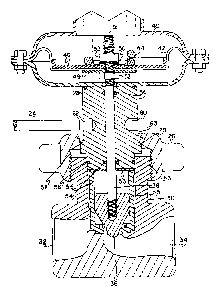Some of the information on this Web page has been provided by external sources. The Government of Canada is not responsible for the accuracy, reliability or currency of the information supplied by external sources. Users wishing to rely upon this information should consult directly with the source of the information. Content provided by external sources is not subject to official languages, privacy and accessibility requirements.
Any discrepancies in the text and image of the Claims and Abstract are due to differing posting times. Text of the Claims and Abstract are posted:
| (12) Patent: | (11) CA 2043899 |
|---|---|
| (54) English Title: | BONNET NUT WITH IMPROVED SAFETY CHARACTERISTICS |
| (54) French Title: | BOULON DE CHAPEAU A CARACTERISTIQUE DE SECURITE AMELIOREE |
| Status: | Term Expired - Post Grant Beyond Limit |
| (51) International Patent Classification (IPC): |
|
|---|---|
| (72) Inventors : |
|
| (73) Owners : |
|
| (71) Applicants : |
|
| (74) Agent: | OSLER, HOSKIN & HARCOURT LLP |
| (74) Associate agent: | |
| (45) Issued: | 2001-08-28 |
| (22) Filed Date: | 1991-06-05 |
| (41) Open to Public Inspection: | 1991-12-07 |
| Examination requested: | 1998-06-02 |
| Availability of licence: | N/A |
| Dedicated to the Public: | N/A |
| (25) Language of filing: | English |
| Patent Cooperation Treaty (PCT): | No |
|---|
| (30) Application Priority Data: | ||||||
|---|---|---|---|---|---|---|
|
A valve assembly includes a bonnet that is
captivated in a valve body stem mount by means of a
threaded bonnet nut. A pair of opposed pry holes are
formed in the bonnet at a point above the top of the
fully seated bonnet nut. Loosening of the bonnet nut
enables a bonnet that is stuck in the body stem mount
to be pryed loose with a pry bar inserted in one or
both of the pry holes and levered against the top of
the bonnet nut. The bonnet holes also provide a visual
indication of movement of the bonnet and whether there
is pressure in the valve body.
Note: Claims are shown in the official language in which they were submitted.
Note: Descriptions are shown in the official language in which they were submitted.

2024-08-01:As part of the Next Generation Patents (NGP) transition, the Canadian Patents Database (CPD) now contains a more detailed Event History, which replicates the Event Log of our new back-office solution.
Please note that "Inactive:" events refers to events no longer in use in our new back-office solution.
For a clearer understanding of the status of the application/patent presented on this page, the site Disclaimer , as well as the definitions for Patent , Event History , Maintenance Fee and Payment History should be consulted.
| Description | Date |
|---|---|
| Inactive: Agents merged | 2013-10-22 |
| Inactive: Expired (new Act pat) | 2011-06-05 |
| Inactive: IPC from MCD | 2006-03-11 |
| Letter Sent | 2003-09-15 |
| Grant by Issuance | 2001-08-28 |
| Inactive: Cover page published | 2001-08-27 |
| Pre-grant | 2001-05-30 |
| Inactive: Final fee received | 2001-05-30 |
| Notice of Allowance is Issued | 2001-01-05 |
| Notice of Allowance is Issued | 2001-01-05 |
| Letter Sent | 2001-01-05 |
| Inactive: Approved for allowance (AFA) | 2000-12-07 |
| Amendment Received - Voluntary Amendment | 2000-08-11 |
| Inactive: S.30(2) Rules - Examiner requisition | 2000-02-15 |
| Amendment Received - Voluntary Amendment | 1998-08-05 |
| Inactive: Application prosecuted on TS as of Log entry date | 1998-06-22 |
| Letter Sent | 1998-06-22 |
| Inactive: Status info is complete as of Log entry date | 1998-06-22 |
| Request for Examination Requirements Determined Compliant | 1998-06-02 |
| All Requirements for Examination Determined Compliant | 1998-06-02 |
| Application Published (Open to Public Inspection) | 1991-12-07 |
There is no abandonment history.
The last payment was received on
Note : If the full payment has not been received on or before the date indicated, a further fee may be required which may be one of the following
Please refer to the CIPO Patent Fees web page to see all current fee amounts.
| Fee Type | Anniversary Year | Due Date | Paid Date |
|---|---|---|---|
| MF (application, 7th anniv.) - standard | 07 | 1998-06-05 | 1998-05-25 |
| Request for examination - standard | 1998-06-02 | ||
| MF (application, 8th anniv.) - standard | 08 | 1999-06-07 | 1999-05-31 |
| MF (application, 9th anniv.) - standard | 09 | 2000-06-05 | 2000-05-30 |
| Final fee - standard | 2001-05-30 | ||
| MF (application, 10th anniv.) - standard | 10 | 2001-06-05 | 2001-06-04 |
| MF (patent, 11th anniv.) - standard | 2002-06-05 | 2002-05-16 | |
| MF (patent, 12th anniv.) - standard | 2003-06-05 | 2003-05-20 | |
| Registration of a document | 2003-08-07 | ||
| MF (patent, 13th anniv.) - standard | 2004-06-07 | 2004-05-17 | |
| MF (patent, 14th anniv.) - standard | 2005-06-06 | 2005-05-09 | |
| MF (patent, 15th anniv.) - standard | 2006-06-05 | 2006-05-05 | |
| MF (patent, 16th anniv.) - standard | 2007-06-05 | 2007-05-07 | |
| MF (patent, 17th anniv.) - standard | 2008-06-05 | 2008-05-12 | |
| MF (patent, 18th anniv.) - standard | 2009-06-05 | 2009-05-14 | |
| MF (patent, 19th anniv.) - standard | 2010-06-07 | 2010-05-11 | |
| MF (application, 2nd anniv.) - standard | 02 | 1993-06-07 |
Note: Records showing the ownership history in alphabetical order.
| Current Owners on Record |
|---|
| FISHER CONTROLS INTERNATIONAL, INC. |
| FISHER CONTROLS INTERNATIONAL LLC |
| Past Owners on Record |
|---|
| ALAN DAVID BREMERS |
| MELVIN LEW OSGOOD |